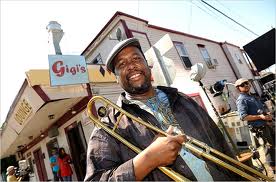 Nicholas Lemann, a native of New Orleans, writing apropos of David Simon’s Treme in the New York Review of Books:
Nicholas Lemann, a native of New Orleans, writing apropos of David Simon’s Treme in the New York Review of Books:
New Orleans is at once a welcoming and an inaccessible city. As a tourist town it has no choice but to be friendly to visitors. Its charms, which are abundantly on display in Treme–not just the music but the food, the domestic architecture, and the street culture–are matters of public expression. On the other hand New Orleans is an old, provincial city, whose distinctiveness comes substantially from its being cut off from many of the main currents of American culture. It’s an easy city to come from and a hard city to move to; full membership can take a generation or two to achieve. So while New Orleans necessarily and relentlessly entertains its visitors, the better one gets to know it the more often one is reminded that one doesn’t, really. A certain kind of New Orleanian gets very invested in becoming a walking encyclopedia on everything–the real stuff, not the tourist stuff–about the city, and a certain kind of newcomer gets very invested in establishing New Orleans bona fides by learning everything that the semiprofessional New Orleans insiders know.
Me, writing in Pops: A Life of Louis Armstrong about a city that I’d never seen when I penned the following paragraph five years ago:
To the northerner New Orleans is another country, seductive and disorienting, a steamy, shabby paradise of spicy cooking, wrought-iron balconies, and streets called Desire and Elysian Fields, a place where the signs advertise such mysterious commodities as po-boys and muffuletta and no one is buried under ground. We’ll take the boat to the land of dreams, the pilgrim hears in his mind’s ear as he prowls the French Quarter, pushing through the hordes of tipsy visitors and wondering whether the land of his dreams still exists–if it ever did. Rarely does he linger long enough to pierce the veneer of local color with which the natives shield themselves from the tourist trade. At the end of his stay he knows no more than when he came, and goes back home to puzzle out all that he has seen and smelled and tasted. A.J. Liebling, a well-traveled visitor from up north, saw New Orleans as a Mediterranean port transplanted to the Gulf of Mexico, a town of civilized pleasures whose settlers “carried with them a culture that had ripened properly, on the tree.” He knew what he was seeing, but Walker Percy, who lived and died there, cast a cooler eye on the same sights: “The ironwork on the balconies sags like rotten lace….Through deep sweating carriageways one catches glimpses of courtyards gone to jungle.” Unlike Liebling, he caught the smell of decay.
Never underestimate the power of research, Mr. Lemann.
